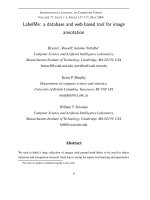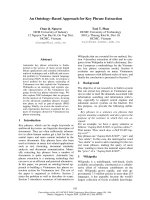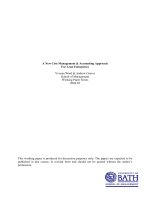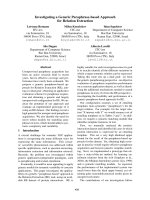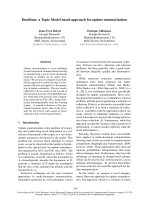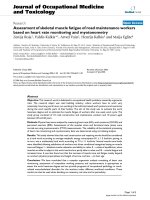A variational mode decomposition based approach for heart rate monitoring using wrist type photoplethysmographic signals during intensive physical exercise
Bạn đang xem bản rút gọn của tài liệu. Xem và tải ngay bản đầy đủ của tài liệu tại đây (696.51 KB, 5 trang )
Journal of Science & Technology 131 (2018) 100-104
A Variational Mode Decomposition-Based Approach for Heart Rate
Monitoring using Wrist-Type Photoplethysmographic Signals during
Intensive Physical Exercise
Thi-Thao Tran, Van-Truong Pham *, Dang-Thanh Bui
Hanoi University of Science and Technology, No. 1, Dai Co Viet, Hai Ba Trung, Hanoi, Viet Nam
Received: September 07, 2018; Accepted: November 26, 2018
Abstract
Heart rate monitoring using photoplethysmographic (PPG) signals recorded from wrist during intensive
physical exercise is challenging because the PPG signals are contaminated by strong motion artifact. In this
paper, we present a new approach for PPG based heart rate monitoring. We first perform the variational
mode decomposition to decompose the PPG signal into multiple modes then eliminate the modes whose
frequencies coincides with those from accelerator signals. Finally, the spectral analysis step is applied to
estimate the spectrum of the signal and selects the spectral peaks corresponding to heart rate. Experimental
results on a public available dataset recorded from 12 subjects during fast running validate the performance
of the proposed algorithm.
Keywords: Adaptive motion artifact cancellation, Photoplethysmographic (PPG), Heart rate monitoring
Variational mode decomposition, Spectral analysis
1. Introduction*
There have many signal processing algorithms
for motion artifact reduction from PPG signals using
the simultaneously recorded accelerometer signals
i.e., adaptive filtering [4, 6, 7], independent
component analysis [8], spectral subtraction [9]
models. More recently, the empirical mode
decomposition (EMD) [10] has been proposed for
MA reduction for PPG signals [3, 11]. Though having
advantages in motion artifact cancellation, EMD have
shortcomings. In the EMD, the mode-mixing problem
should be handled, and the number of modes vary
with different signals. As an alternative to the EMD
approach, variational mode decomposition (VMD)
[12] has been proposed to address shortcomings of
EMD. Since introduced in 2014, VMD has attracted a
lot of interests from many researchers in various
signal processing applications such as detecting rubimpact fault of the rotor system, and power quality
events. However, to the best of our knowledge, the
VMD has not been studied in PPG signals for heart
rate monitoring.
Heart rate (HR) monitoring is necessary in
detection of heart diseases, health monitoring for the
elderly, and in other applications. Heart rates
traditionally
were
estimated
by
using
electrocardiography (ECG) signals with sensors
attached to the chest, hand and reference ground [1].
As an alternative to ECG signal, PPG signal is
preferred for heart rate measurement in many
applications due to its low cost and convenience [2].
Recently, with the emergence of wearable devices
such as smartwatches and wristbands, the HR
monitoring has attached much attention.
PPG signals can be recorded by illuminating the
skin with a light emitting diode and detecting changes
in the reflected light, so the periodicity of the PPG
signal represents heart rate. The PPG signals can be
acquired from different body parts like fingertip,
wrist and earlobe [3]. Thus, the embedded pulse
oximeters in smartwatches and wristbands can
facilitate noninvasive monitoring of heart rate.
However, PPG signals can be easily contaminated by
motion artifact (MA) due to the loose interface
between the pulse oximeter and skin surface [1].
Especially, when the signals are measured in subjects
during their intensive physical exercise like fast
running or cycling. Therefore, accurate heart rate
estimation from wrist-type PPG signals during
intensive physical exercise is challenging [2, 4, 5].
*
In this paper, inspired by the VMD, we present
an automatic method to reduce motion artifact from
the PPG signals. The PPG signal that is contaminated
with motion artifact, is first decomposed into
different modes by the VMD. After decomposition of
the PPG signal, the instantaneous frequencies of the
modes are calculated and compared with the
fundamental frequency of the accelerator signals. The
mode whose frequency coincides with accelerator
frequency will be assigned as the motion artifact
component, then the remaining modes are combined
to obtain a cleansed PPG signal. Based on the
Corresponding author: Tel.: (+84) 868.159.918
Email:
100
Journal of Science & Technology 131 (2018) 100-104
cleansed PPG signal, the spectral analysis is
implemented, and the heart rate monitoring is
performed. The proposed algorithm has been applied
for the IEEE Signal Processing Cup 2015 dataset and
obtained comparative results.
coincides with the true heart rate, 1.95Hz (equivalent
to 117bpm). However, in epoch (B), in the presence
of strong motion artifact, the maximal value of the
spectral envelope is 2.81Hz, does not coincide with
the true heart rate 2.26Hz (equivalent to 135bpm).
2. Variational Mode Decomposition
3.2. PPG signal decomposition
Variational mode decomposition (VMD)
proposed by Dragomiretskiy and Zosso [12] is a
signal processing technique that decomposes a realvalued signal, f(t), into different levels modes uk, that
have specific sparsity properties. It is assumed that
each mode k to be concentrated around a center
pulsation k determined during the decomposition
process. Thus, the sparsity of each mode is chosen to
be its bandwidth in spectral domain. To obtain the
mode bandwidth, the following steps should be
implemented: (1) applying Hilbert transform to each
mode uk in order to obtain unilateral frequency
spectrum. (2) Shifting the mode’s frequency spectrum
to “baseband”, by using an exponential tuned to the
respective estimated center frequency. (3) Estimation
of the bandwidth through the H1 Gaussian
smoothness of the demodulated signal, i.e. the
squared L2-norm of the gradient. More detail about
VMD approach can be found in [12]
As analyzed above, with strong motion artifact, it
is difficult to estimate the heart rate from frequency
distribution directly from the PPG signal. To separate
the heart rate from the motion artifact, we apply the
mode decompose approach using VMD. In more
detail, after being filtered by bandpass filter, the PPG
signals are applied to the VMD method [12]. By the
VMD algorithm, the signal can be separated into
modes. Figure 2 shows an example of the
decomposition step by VMD for a representative
epoch B in Fig.1. In this epoch, the VMD
decomposes the PPG signal into 5 modes. The
frequency distribution obtained by performing Fast
Fourier Transform (FFT) for each mode. Along with
the time-series plot of each mode, the frequency
distribution with spectral envelopes of PPG epoch
and decomposed modes are also provided. As can be
observed from Fig 2, though not being identified
from the PPG epoch, the heart rate is separated from
the highest spectral envelope of mode 3. It also can
be observed from Fig.2 that the maximal envelope in
the input PPG is associated with the motion artifact,
and this maximal value coincides with the maximal
envelope in mode 4.
3. The proposed algorithm
The proposed algorithm for heart rate
monitoring includes following steps: preprocessing,
variational mode decomposition, motion artifact
cancellation and heart rate estimation.
3.3. MA cancellation and HR estimation
3.1. Signal Preprocessing and MA analysis
Based on PPG and MA signals, in this study, we
propose a new approach for MA cancellation. Our
approach stems from the fact that the acquired PPG
signal is contaminated with motion artifact. This can
be seen in Fig.3, the two envelopes (peaks denoted by
circles) in the input PPG signal coincide with the
envelopes in the accelerators. Accordingly, it is
reasonable to remove the MA signal from the
decomposed PPG’s modes.
Input signals including PPG and accelerometer
signals are first filtered with a 4th order Butterworth
band-pass filter (0.5-4Hz) to remove baseline wander
and high frequencies. The PPG signals are then
normalized to zero mean for further processing. The
accelerometer signals are resampled to 125Hz, the
sampling rate of the PPG signals. The data of each
subject are divided into multiple epochs with 50%
overlapping, each epoch lasts 10 seconds.
The paradigm for the proposed approach to
estimate the PPG signal is described as follows. For
each signal epoch, we decompose the PPG into
modes, then compute the instantaneous frequency of
each mode. The mode whose instantaneous frequency
outside the range [0.5-3.5] Hz is excluded. Besides,
we calculate a set of spectral envelopes from
frequency distributions of the accelerometer signals,
denoted as Facc of that epoch. Then, we compare the
frequency of the modes (f1, f2,.., fN) with the MA
frequency set, Facc. If the frequency of one mode
coincides with Facc with a tolerance of 0.15Hz, it is
eliminated. The remaining modes are then combined
to get a cleansed PPG signal. After the motion artifact
Since the PPG signal is corrupted by the motion
artifact, the frequency of motion artifact signal
measured by accelerometer contribute to the PPG
signal. Then the heart rate can be estimated by
removing the MA component from the PPG signal.
However, with strong motion artifact, it is difficult to
estimate the heart rate from frequency distribution of
the PPG signal. This is demonstrated in Fig.1. In this
figure, two epochs from a recording are extracted,
given the true heart rates, denoted with a circle in the
frequency distributions of the corresponding epochs.
In particular, in epoch (A), with less motion artifact,
the maximal value of the spectral envelope is 1.95Hz,
101
Journal of Science & Technology 131 (2018) 100-104
Frequency
(Hz)
cancellation step, we estimated the heart rate from the
cleansed PPG signals adapting the spectral peak
A
tracking algorithms by Zhang et al. [5].
B
A
A
(a)
Heart rate
(bpm)
Frequency (Hz)
Time (sec)
Time (sec)
(e)
(c)
B
Time (sec)
B
Frequency (Hz)
Time (sec)
(b)
(f)
(d)
Fig. 1. Representative illustration for the challenge of HR estimation during physical exercise: Plots (a) and (b)
shows the spectrogram of a PPG data of a subject and the true heart rate in beat per minute (bpm). Plots (c) and
(d) show examples of two epoch (A) and (B) from the PPG subject. Plots (e) and (f) show the spectral envelopes
of the examples. The true HR is denoted with a circle.
Input PPG
Input PPG
Input PPG
Mode 1
Mode 1
Mode 2
Mode 2
Mode 3
Mode 3
Mode 3
Mode 4
Mode 4
Mode 4
Mode 5
Mode 5
Mode 5
Mode 1
Mode 2
45
Time (sec)
Time (sec)
(a)
50
Frequency (Hz)
(c)
(b)
55
Fig. 2. PPG signal and its decomposed modes: (a) signals in time domain, (b) spectrograms, and (c) frequency
distributions. Red circle denoted the highest spectral envelope.
Table 1. The performance of the proposed algorithm for HR estimation from 12 subjects
Subjects
1
2
3
4
5
6
7
8
9
10
11
12
avAE (bpm)
3.60
2.44
1.45
1.90
1.38
1.54
1.28
1.87
1.28
5.53
1.98
3.31
sdAE (bpm)
3.20
2.55
1.32
1.79
1.26
1.72
1.04
1.59
1.03
7.19
1.91
5.37
avRE (%)
2.87
2.39
1.18
1.64
1.06
1.34
1.04
1.64
1.16
3.76
1.29
2.79
102
Journal of Science & Technology 131 (2018) 100-104
Input
PPG
Accelerator X
Input
Input
PPG
PPG
Accelerator X
Accelerator X
Accelerator Y
Accelerator Y
Accelerator Y
Accelerator Z
Accelerator Z
Accelerator Z
Time
Frequency
Time
(sec)
(a)
(Hz)
(c)
(sec)
(b)
Fig. 3. Signals, corresponding frequency distributions, and spectrograms of a PPG, accelerometer signals (X, Y,
and Z axes). (a) Signals in time domain; (b) Gabor Spectrograms; and (c) Frequency distributions. Red circle
denoted the highest spectral envelope.
4. Evaluation Results
avRE =
4.1. Database and Evaluation metrics
We apply the proposed method for 12 subjects
during intensive physical exercises from the dataset
provided for the IEEE Signal Processing Cup 2015,
For each subject, the PPG sensors and three-axis
accelerometer were embedded in a comfortable
wristband. The ECG signal was recorded
simultaneously for computing reference heart rate,
then the heart rates from ECG are used as ground
truth for heart rate estimation by PPG and accelerator
signal. The data including PPG, ECG, and
accelerators signals lasts from 300 to 350 seconds.
4.3. Performance
estimation
sdAE =
1
N
(1)
i
i =1
N
( AE − avAE )
i
2
i =1
AEi
100
true (i )
(3)
assessment
of
Heart
rate
The performance of the proposed algorithm for
HR estimation for 12 subjects is summarized in Table
1. The reported results included following
parameters: Average Absolute Error, Standard
Deviation of Absolute Error, and Average Relative
Error (avRA), as computed in Eqs. 1-3. The reported
results by the proposed method for 12 subjects of the
dataset achieves an average absolute error (avAE) of
2.29 bpm, that is smaller than avAE value reported by
the TROIKA method, 2.34 bpm, in [5]. The average
absolute value in this study, though larger than that
commonly obtained by using gel electrodes, it is
adequate since the acquisition is peformed during
intensive physical exercises, with large heart rate
variabilty. From this table, we can see that subject 9
gives the best performance achieved by the proposed
HR estimation algorithm. The agreement between the
estimated HR for subject 9 by the proposed method
and the true heart rate is interpreted in Fig.4.
N
AE
f
(AE) used to evaluate the accuracy of each HR
estimate, with fest(i) and ftrue (i) respectively denote
the estimated and true heart rate values in the i-th
epoch, in beats per minute (bpm).
To evaluate the performance of the proposed
heart rate estimate, we compare the heart rates
computed by the proposed approach with those by
reference heart rates. The metric includes: Average
Absolute Error, Standard Deviation of Absolute
Error, and Average Relative Error (avRA) are which
are usually computed in other studies [1, 5]. The
Average Absolute Error (avAE), Standard Deviation
of Absolute Error (stAE), and Average Relative Error
(avRE) are defined as:
1
N
N
where AEi = fest (i) − ftrue (i) is the Absolute error
4.2. Metrics
avAE =
1
N
(2)
To further demonstrate the correlation and
agreement between the estimated and true heart rates,
i =1
103
Journal of Science & Technology 131 (2018) 100-104
Biomedical Engineering, vol. 64, pp. 2016-2024,
2017.
we provided the Pearson correlation plots and BlandAltman plots of heart rates in Fig.5. The figure shows
high correlation coefficient (R=0.99) and a good
agreement between the estimated heart rates by the
proposed algorithm and the true heart rates.
[2]. J. Allen, Photoplethysmography and its application in
clinical physiological measurement, Phys Meas, vol.
28, pp. 1-39, 2007.
[3]. E. Khan, F. Al Hossain, S. Uddin, S. Alam, and M.
Hasan, A Robust Heart Rate Monitoring Scheme
Using Photoplethysmographic Signals Corrupted by
Intense Motion Artifacts, IEEE Transactions on
Biomedical Engineering, vol. 63, pp. 550 - 562, 2016.
[4]. M. Mashhadi, E. Asadi, M. Eskandari, S. Kiani, and
F. Marvasti, Heart Rate Tracking using Wrist-Type
Photoplethysmographic (PPG) Signals during
Physical Exercise with Simultaneous Accelerometry,
IEEE Signal Processing Letters, vol. 23, pp. 227-231,
2016.
Fig. 4. An example of the heart rate estimation results
on subject 9 using the proposed algorithm
[5]. Z. Zhang, Z. Pi, and B. Liu, TROIKA: A General
Framework for Heart Rate Monitoring Using WristType Photoplethysmographic Signals During
Intensive Physical Exercise, IEEE Transactions on
Biomedical Engineering vol. 62, pp. 522 - 531, 2015.
[6].
R. Yousefi, M. Nourani, S. Ostadabbas, and I.
Panahi, A motion-tolerant adaptive algorithm for
wearable photoplethysmographic biosensors, IEEE
Journal of Biomedical and Health Informatics, vol.
18, pp. 670 - 681, 2014.
[7]. M. Ram, K. V. Madhav, E. H. Krishna, N. R.
Komalla, and K. A. Reddy, A novel approach for
motion artifact reduction in PPG signals based on ASLMS adaptive filter, IEEE Transactions on
Instrumentation and Measurement vol. 61, pp. 1445 1457, 2012.
Fig 5. The Pearson correlation (a) and Bland-Altman
plot (b) of the heart rate estimation of 12 subjects in
the dataset. R denotes the correlation coefficient.
5. Conclusion
[8]. B. Kim and S. Yoo, Motion artifact reduction in
photoplethysmography using independent component
analysis, IEEE Trans. Biomed. Eng., vol. 53, pp. 566568, 2006.
The study has proposed a new approach for
heart rate monitoring from the PPG signals during
physical exercise. The PPG contaminated with
motion artifact is decomposed in to modes via VMD.
The frequency of each mode is computed and
compared with fundamental frequency of the motion
artifact related signal. Then, the cleansed PPG signal
is estimated by eliminating the modes whose
instantaneous frequencies coincided with the
frequency of MA related signal. The assessment of
heart rates estimated by proposed algorithm shows a
good agreement with those reference heart rate, that
demonstrates the performance of the proposed
method.
[9]. B. Sun and Z. Zhang, Photoplethysmography-based
heart rate monitoring using asymmetric least squares
spectrum subtraction and bayesian decision theory,
IEEE Sensors Journal vol. 15, pp. 7161 - 7168, 2015.
[10]. N. E. Huang, Z. Shen, S. R. Long, M. C. Wu, E. H.
Shih, Q. Zheng, et al., The empirical mode
decomposition method and the Hilbert spectrum for
non-stationary time series analysis, Proc. R. Soc.
Lond., vol. 454A, pp. 903–995, 1998.
[11]. X. Sun, P. Yang, Y. Li, Z. Gao, and Y.-T. Zhang,
Robust
heart
beat
detection
from
photoplethysmography interlaced with motion
artifacts, based on empirical mode decomposition, in
Proceedings of International Conference on
Biomedical and Health Informatics, pp. 775-778,
2012.
Acknowledgments
This research is funded by the Hanoi University
of Science and Technology (HUST) under project
number T2017-PC-122, and T2017-PC-099.
[12]. K. Dragomiretskiy and D. Zosso, Variational mode
decomposition, IEEE Transactions on Signal
Processing, vol. 62, pp. 531 - 544, 2014.
References
[1]. A. Temko, Accurate heart rate monitoring during
physical exercises using PPG, IEEE Transactions on
104
